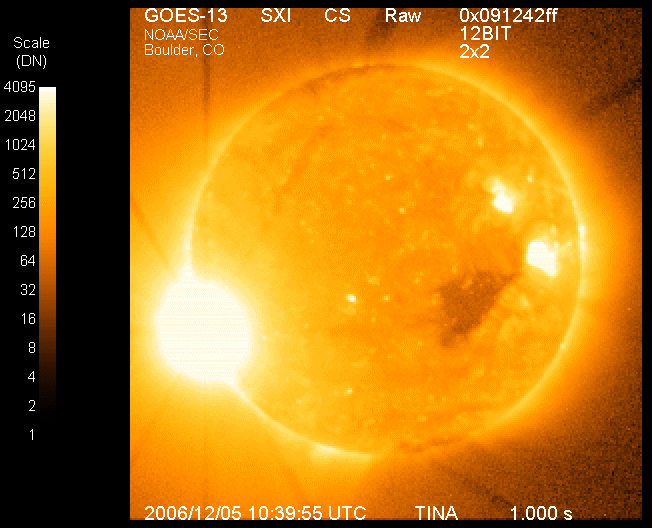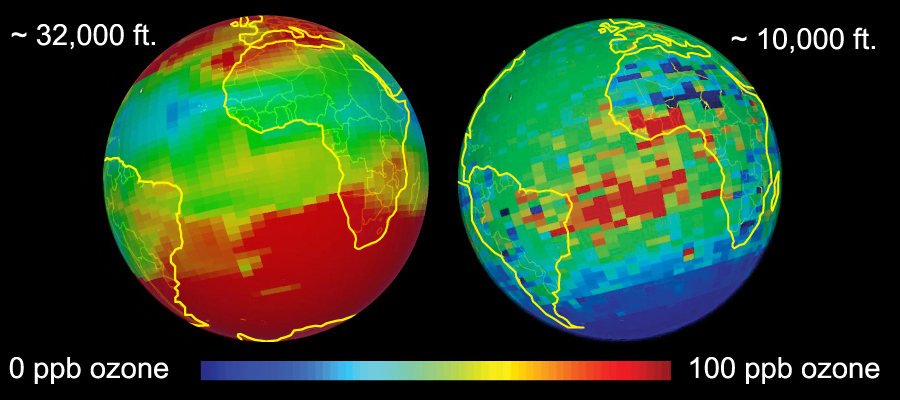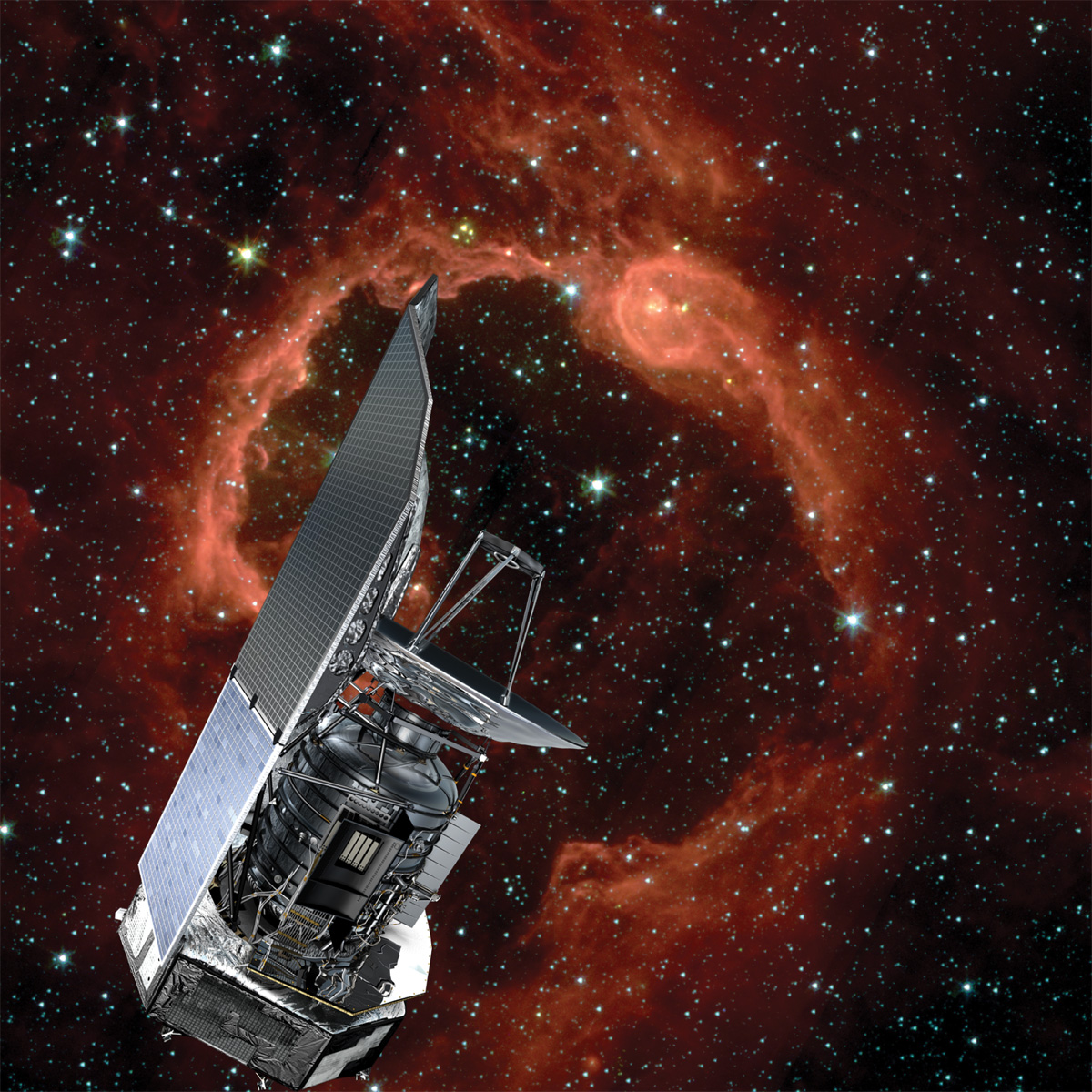Next Launch
Total Students
2,609
Total Launches
683
Eggs Survived
418 61.2%
Rockets Survived
536 78.5%
Dec. 1, 2009
Sunglasses for a Solar Observatory
by Patrick Barry
In December 2006, an enormous solar flare erupted on the Sun's surface. The blast hurled a billion-ton cloud of gas (a coronal mass ejection, or CME) toward Earth and sparked days of intense geomagnetic activity with Northern Lights appearing across much of the United States.
While sky watchers enjoyed the show from Earth's surface, something ironic was happening in Earth orbit.
At the onset of the storm, the solar flare unleashed an intense pulse of X-rays. The flash blinded the Solar X-Ray Imager (SXI) on NOAA's GOES-13 satellite, damaging several rows of pixels. SXI was designed to monitor solar flares, but it must also be able to protect itself in extreme cases.
That's why NASA engineers gave the newest Geostationary Operational Environmental Satellite a new set of sophisticated "sunglasses." The new GOES-14 launched June 27 and reached geosynchronous orbit July 8.
Its "sunglasses" are a new flight-software package that will enable the SXI sensor to observe even intense solar flares safely. Radiation from these largest flares can endanger military and civilian communications satellites, threaten astronauts in orbit, and even knock out cities' power grids. SXI serves as an early warning system for these flares and helps scientists better understand what causes them.
"We wanted to protect the sensor from overexposure, but we didn't want to shield it so much that it couldn't gather data when a flare is occurring," says Cynthia Tanner, SXI instrument systems manager for the GOES-NOP series at NASA's Goddard Space Flight Center in Greenbelt, Maryland. (GOES-14 was called GOES-O before achieving orbit).
Shielding the sensor from X-rays also reduces the amount of data it can gather about the flare. It's like stargazing with dark sunglasses on. So NASA engineers must strike a balance between protecting the sensor and gathering useful data.
When a dangerous flare occurs, the new SXI sensor can protect itself with five levels of gradually "darker" sunglasses. Each level is a combination of filters and exposure times carefully calibrated to control the sensor's exposure to harmful high-energy X-rays.
As the blast of X-rays from a major solar flare swells, GOES-14 can step up the protection for SXI through these five levels. The damaged sensor on GOES-13 had only two levels of protection-low and high. Rather than gradually increasing the amount of protection, the older sensor would remain at the low level of protection, switching to the high level only when the X-ray dose was very high.
"You can collect more science while you're going up through the levels of protection," Tanner says. "We've really fine-tuned it."
Forecasters anticipate a new solar maximum in 2012-2013, with plenty of sunspots and even more solar flares. "GOES-14 is ready," says Tanner.
For a great kid-level explanation of solar "indigestion" and space weather, check out spaceplace.nasa.gov/en/kids/goes/spaceweather.
This article was provided by the Jet Propulsion Laboratory, California Institute of Technology, under a contract with the National Aeronautics and Space Administration.
 X-9 class solar flare December 6, 2006, as seen by GOES-13's Solar X-ray Imager. It was one of the strongest flares in the past 30 years.
X-9 class solar flare December 6, 2006, as seen by GOES-13's Solar X-ray Imager. It was one of the strongest flares in the past 30 years.
Jan. 1, 2010
Building a Case Against Ozone
by Patrick Barry
When it comes to notorious greenhouse gases, carbon dioxide is like Al Capone—always in the headlines. Meanwhile, ozone is more like Carlo Gambino—not as famous or as powerful, but still a big player.
After tracking this lesser-known climate culprit for years, NASA’s Tropospheric Emission Spectrometer (TES) has found that ozone is indeed a shifty character. Data from TES show that the amount of ozone—and thus its contribution to the greenhouse effect—varies greatly from place to place and over time.
"Ozone tends to be localized near cities where ozone precursors, such as car exhaust and power plant exhaust, are emitted," says Kevin Bowman, a senior member of the TES technical staff at the Jet Propulsion Laboratory. But the ozone doesn't necessarily stay in one place. Winds can stretch the ozone into long plumes. "Looking out over the ocean we can see ozone being transported long distances over open water."
Unlike CO2, ozone is highly reactive. It survives in the atmosphere for only a few hours or a few days before it degrades and effectively disappears. So ozone doesn't have time to spread out evenly in the atmosphere the way that CO2 does. The amount of ozone in one place depends on where ozone-creating chemicals, such as the nitrogen oxides in car exhaust. are being released and which way the wind blows.
This short lifespan also means that ozone could be easier than CO2 to knock off.
"If you reduce emissions of things that generate ozone, then you can have a quicker climate effect than you would with CO2," Bowman says. "From a policy standpoint, there’s been a lot of conversation lately about regulating short-lived species like ozone."
To be clear, Bowman isn’t talking about the famous "ozone layer." Ozone in this high-altitude layer shields us from harmful ultraviolet light, so protecting that layer is crucial. Bowman is talking about ozone closer to the ground, so-called tropospheric ozone. This "other" ozone at lower altitudes poses health risks for people and acts as a potent greenhouse gas.
TES is helping scientists track the creation and movement of low-altitude ozone over the whole planet each day. "We can see it clearly in our data," Bowman says. Countries will need this kind of data if they decide to go after the heat-trapping gas.
Ozone has been caught red-handed, and TES is giving authorities the hard evidence they need to prosecute the case.
Learn more about TES and its atmospheric science mission at tes.jpl.nasa.gov. The Space Place has a fun “Gummy Greenhouse Gases” activity for kids that will introduce them to the idea of atoms and molecules. Check it out at spaceplace.nasa.gov/en/kids/tes/gumdrops.
This article was provided by the Jet Propulsion Laboratory, California Institute of Technology, under a contract with the National Aeronautics and Space Administration.
 These images are TES ozone plots viewed with Google Earth. Colors map to tropospheric ozone concentrations. The image on the left shows ozone concentrations at an altitude of approximately 32,000 feet, while the one on the right shows ozone at approximately 10,000 feet. The measurements are monthly averages over each grid segment for December 2004.
These images are TES ozone plots viewed with Google Earth. Colors map to tropospheric ozone concentrations. The image on the left shows ozone concentrations at an altitude of approximately 32,000 feet, while the one on the right shows ozone at approximately 10,000 feet. The measurements are monthly averages over each grid segment for December 2004.
Feb. 1, 2010
What is hiding in the cold, cosmic darkness?
by Staff
Exploring the universe is a bit like groping around a dark room. Aside from the occasional pinprick of starlight, most objects lurk in pitch darkness. But with the recent launch of the largest-ever infrared space telescope, it's like someone walked into the room and flipped on the lights.
Suddenly, those dark spaces between stars don’t appear quite so empty. Reflected in the Herschel Space Observatory's 3.5-meter primary mirror, astronomers can now see colder, darker celestial objects than ever before—from the faint outer arms of distant galaxies to the stealthy “dark asteroids” of our own solar system.
Many celestial objects are too cold to emit visible light, but they do shine at much longer infrared wavelengths. And Herschel can observe much longer infrared wavelengths than any space telescope before (up to 672 microns). Herschel also has 16 times the collecting area, and hence 16 times better resolution, than previous infrared space telescopes. That lets it resolve details with unprecedented clarity. Together, these abilities open a new window onto the universe.
”The sky looks much more crowded when you look in infrared wavelengths,” says George Helou, director of the NASA Herschel Science Center at Caltech. “We can't observe the infrared universe from the ground because our atmosphere blocks infrared light, and emits infrared itself. Once you get above the atmosphere, all of this goes away and suddenly you can look without obstruction.”
Herschel launched in May from the Guiana Space Centre in French Guiana aboard a European Space Agency Ariane 5 rocket. Since then, it has expanded the number of distant galaxies observed at far infrared wavelengths from a few hundred to more than 28,000. And with the instrument testing and system check-out phases finally completed, the discoveries are only now beginning.
Beyond simply imaging these dark objects, Herschel can identify the presence of chemicals such as carbon monoxide and water based on their spectral fingerprints. “We will be able to decipher the chemistry of what's going on during the beginnings of star formation, in the discs of dust and gas that form planets, and in the lingering aftermath of stellar explosions,” Helou says.
And those are just the expected things. Who knows what unexpected discoveries may come from “flipping on the lights?” Helou says “we can't wait to find out.”
Herschel is a European Space Agency mission, with science instruments provided by a consortium of European-led institutes and with important participation by NASA. See the ESA Herschel site at sci.esa.int/science-e/www/area/index.cfm?fareaid=16. Also, see the NASA sites at herschel.jpl.nasa.gov, www.herschel.caltech.edu, and www.nasa.gov/mission_pages/herschel. Kids can learn about infrared light by browsing through the Infrared Photo Album at The Space Place, spaceplace.nasa.gov/en/kids/sirtf1/sirtf_action.shtml.
This article was provided by the Jet Propulsion Laboratory, California Institute of Technology, under a contract with the National Aeronautics and Space Administration.
 The Herschel Space Observatory has 3.5-meter primary mirror, allowing astronomers to see colder, darker celestial objects than ever before.
The Herschel Space Observatory has 3.5-meter primary mirror, allowing astronomers to see colder, darker celestial objects than ever before.
March 1, 2010
Deadly Planets-"Terra" firma, but don't go there!
by By Patrick L. Barry and Dr. Tony Phillips
About 900 light years from here is a rocky planet not much bigger than Earth. It goes around its star once every hundred days, a trifle fast, but not too different from a standard Earth-year. At least two and possibly three other planets circle the same star, forming a complete solar system.
Interested? Don't be. Going there would be the last thing you ever do.
The star is a pulsar, PSR 1257+12, the seething-hot core of a supernova that exploded millions of years ago. Its planets are bathed not in gentle, life-giving sunshine but instead a blistering torrent of X-rays and high-energy particles.
"It would be like trying to live next to Chernobyl," says Charles Beichman, a scientist at JPL and director of the Michelson Science Center at Caltech.
Our own Sun emits small amounts of pulsar-like X-rays and high energy particles, but the amount of such radiation coming from a pulsar is "orders of magnitude more," he says. Even for a planet orbiting as far out as the Earth, this radiation could blow away the planet's atmosphere, and even vaporize sand right off the planet's surface.
Astronomer Alex Wolszczan discovered planets around PSR 1257+12 in the 1990s using Puerto Rico’s giant Arecibo radio telescope. At first, no one believed worlds could form around pulsars—it was too bizarre. Supernovas were supposed to destroy planets, not create them. Where did these worlds come from?
NASA’s Spitzer Space Telescope may have found the solution. In 2005, a group of astronomers led by Deepto Chakrabarty of MIT pointed the infrared telescope toward pulsar 4U 0142+61. Data revealed a disk of gas and dust surrounding the central star, probably wreckage from the supernova. It was just the sort of disk that could coalesce to form planets!
As deadly as pulsar planets are, they might also be hauntingly beautiful. The vaporized matter rising from the planets' surfaces could be ionized by the incoming radiation, creating colorful auroras across the sky. And though the pulsar would only appear as a tiny dot in the sky (the pulsar itself is only 20-40 km across), it would be enshrouded in a hazy glow of light emitted by radiation particles as they curve in the pulsar's strong magnetic field.
Wasted beauty? Maybe. Beichman points out the positive: "It's an awful place to try and form planets, but if you can do it there, you can do it anywhere."
Find more news and images from Spitzer at http://www.spitzer.caltech.edu/. In addition, The Space Place Web site features several games related to Spitzer and infrared astronomy, as well as a storybook about a girl who dreamed of finding another Earth. Go to http://tiny.cc/lucy208.
This article was provided by the Jet Propulsion Laboratory, California Institute of Technology, under a contract with the National Aeronautics and Space Administration.
 Artist’s concept of a pulsar and surrounding disk of rubble called a “fallback” disk, out of which new planets could form.
Artist’s concept of a pulsar and surrounding disk of rubble called a “fallback” disk, out of which new planets could form.